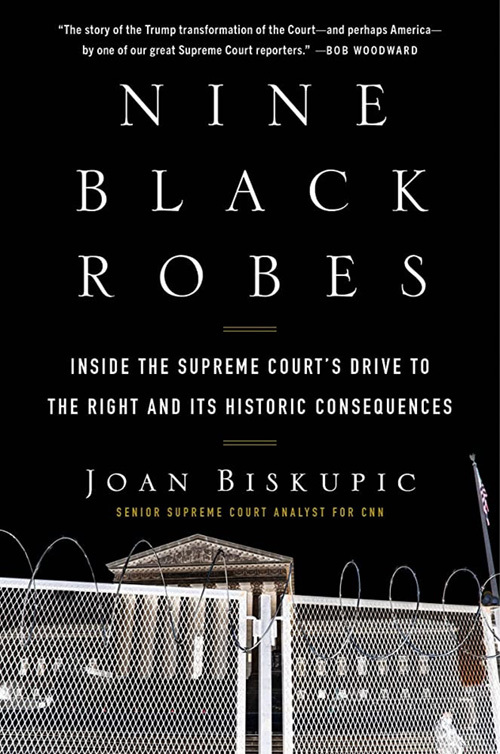- Winter 2023
- Nine Black Robes: Inside the Supreme Court’s Drive to the Right and Its Historic Consequences by Joan Biskupic (HarperCollins, 2023)
Nine Black Robes: Inside the Supreme Court’s Drive to the Right and Its Historic Consequences by Joan Biskupic (HarperCollins, 2023)

The presidency of Donald J Trump may have only been for one term between 2017 and 2021, however, it was a consequential and confounding presidency. Almost since the start of the Trump presidency (and since its end), there has been a steady stream of books, articles, and podcasts about the impact of President Trump on American social and political life. So confounding was he that it necessitated self-help advice about navigating personal psychic pain and interpersonal conflict between friends and family1 because of what he did as president.
Nine Black Robes: Inside the Supreme Court’s Drive to the Right and Its Historic Consequences by Joan Biskupic adds to the rich body of literature about the Trump presidency by examining his impact on the US federal judiciary, and in particular, the US Supreme Court. Biskupic does so by first setting the scene of how Trump, and other actors, helped to shape the court through their appointment of ideologically aligned justices. Biskupic also takes the reader inside the court to detail the inner workings of the court and the relationships between the Justices during the Trump presidency.
The book benefits from Biskupic’s long history as a Supreme Court analyst and journalist on the Supreme Court ‘beat’. She is presently the full-time legal analyst for CNN and before that held positions as the editor-in-charge for Legal Affairs in Reuters and as a Supreme Court correspondent for the Washington Post and USA Today. She is also the author of several biographies of current and former justices of the Supreme Court on both ‘sides’ of the conservative-liberal ideological spectrum.
Although the book is an account of the court during the Trump presidency, it begins in the final year of the Obama presidency, with the death of Justice Scalia in 2016, and the highly controversial decision by Senator McConnell to not hold Senate confirmation hearings for President Obama’s nominee for Justice Scalia’s replacement – then Court of Appeal judge Merrick Garland (now the federal Attorney-General in the Biden administration). That ‘most consequential decision’ led the way to President Trump’s appointment of three Supreme Court justices: Justice Neil Gorsuch (to replace Justice Scalia); Justice Brett Kavanaugh (to replace Justice Anthony Kennedy); and Justice Amy Coney Barrett (to replace Justice Ruth Bader-Ginsberg2).

Biskupic’s deep experience as a Supreme Court reporter and analyst is evident in the extensive research and reporting she did for the book relying on the record of cases, archives including over 100 interviews with people in the court and its orbit ‘including a majority of justices’, as well as former law clerks, regular Supreme Court advocates and academics. In deploying those formidable contacts and skill, Biskupic has written a compelling group portrait of the Supreme Court, capturing the shifting dynamics of the court during the Trump presidency. In the process of doing so she has also described the role of other figures who assisted President Trump in his mission to remake the court, and in turn, the country. These include: White House counsel Don McGahn to whom President Trump delegated the selection of judicial nominees; Leonard Leo, the leader of the Federalist Society, a powerful nongovernment group of conservative members who worked closely with Don McGahn; and Senator Mitch McConnell, who as Senate majority leader controlled the nomination and confirmation process.
The book helps to explain the power of the presidency in judicial appointments. Most significantly, under Trump the court went from a finely balanced court between liberals and conservatives, with one justice (usually Justice Kennedy) tipping the balance in favour of one or the other side, to one with a conservative majority (five Justices) or supermajority (five plus the Chief Justice). In a more finely balanced Court, Chief Justice Roberts (himself a conservative justice) had acted as a moderating influence on the potential excesses of a conservative majority to preserve the ongoing institutional legitimacy of the court (most notably by ‘saving’ President Obama’s Affordable Care Act in a 5-4 decision in which he joined the liberal justices). As the book details, the arrival of Justices Gorsuch, Kavanaugh and Coney Barrett, has significantly diluted Chief Justice Roberts’ ability to moderate decisions. Those new appointments, together with Justices Clarence Thomas and Samuel Alito have created majorities in favour of preferred conservative outcomes independently of the Chief Justice (most notably in the June 2022 decision in Dobbs v Jackson Women’s Health Organisation that moverruled (the court’s existing precedents in) Roe v Wade and Planned Parenthood v Casey).
The book contains numerous insights shared by the justices (unidentified), including the deliberations that took place in several cases. In this regard, the book contains original reporting. For instance, the book details the efforts of the Chief Justice to prevent Roe and Casey being overturned. His goal was to preserve the institutional legitimacy of the court by not overturning settled precedents that had been in place (in the case of Roe) for over 50 years and on which women relied in making important life decisions. Thus, he tried to ‘privately lobby fellow conservatives’ against overruling the existing precedents. He appeared to do so ‘for weeks’ despite the majority judgment in Dobbs having been produced in record time two months after oral argument in the matter, with all five of the justices who formed the eventual majority having joined that decision before the draft leaked, a majority that did not subsequently waver. The book is therefore not just a chronicle of how the court has behaved and developed with the arrival of each Trump appointee, but also a chronicle of how the role of the Chief Justice has waxed, and now waned, during the time he has been the court’s notional leader.
Biskupic’s conclusion is dire: the court’s majority (Justices Thomas, Alito, Gorsuch, Kavanaugh, Coney Barrett) and even the supermajority (when Chief Justice Roberts joins) are ‘laying waste to precedents and, indeed, offering no one confidence that [they are] done with [their] work’. The message of the book is clear. President Trump may no longer be in office, however, his influence on American law carries on and will continue to do so for the foreseeable future, despite public confidence and trust in the court having dropped significantly, most especially after the Dobbs decision.
The highly political manner with which the Supreme Court is treated – from its appointment process to discussions on how a justice ‘votes’ in a case, the characterisation of decisions as being conservative and liberal, the routine identification of judges as the appointee of a particular president in public commentary about judicial officers– (thankfully) has no Australian analogue. The reasons for why that is so await several doctoral theses.
ENDNOTES
1 Amber Jamieson, ‘How to cope with anxiety caused by Donald Trump: experts lend advice’, The Guardian, 27 March 2016; Karen Attiah, ‘Self-care tips for those who are terrified of Trump’s presidency’, The Washington Post, 12 November 2016; N’dea Yancey-Bragg ‘How to navigate awkward political conversations at thanksgiving after a tense election’, USA Today, 23 November 2020; Belinda Luscombe, ‘Fighting With a Family Member Over Politics? Try These 4 Steps’, Time, 19 February 2021.
2 The irony of replacing the liberal, pro rights, Justice Bader-Ginsberg with the conservative, anti-abortion Justice Coney Barrett echoed another appointment in US Supreme Court history when the first African American, liberal, Justice Thurgood Marshall, was replaced by the African American, conservative, Justice Clarence Thomas.
